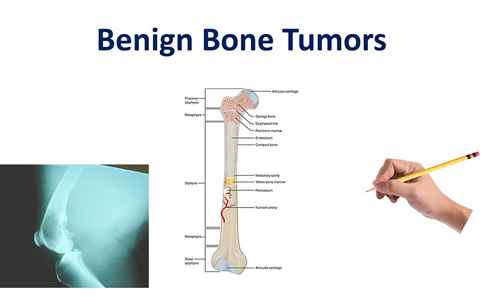Bone Tumors
Benign Bone Tumors are Non Cancerous
Bone Tumors means an abnormal growth of cells within a bone. Bone Tumors may be Cancerous (Malignant) or Non-Cancerous (Benign). In fact, non-cancerous bone tumors are much more common than cancerous ones.
Shreya Hospital in Ghaziabad is the best treatment center of Bone Tumors. Dr.Dev Mishra, Senior Orthopaedic Surgeon is having vast experience of Orthopaedic Treatments and Orthopaedic Surgeries. Operation Theater having advance equipment and Dedicated Team of Orthopaedic Specialists result in successful treatment of Bone Tumors.

Benign Bone Tumors
Benign Bone Tumors are Non-Cancerous. These tumors may cause pain that gets worse and not better. Some benign bone tumors may need treatment to stop them from destroying bone. Other non-cancerous bone tumors may require no treatment at all.
Risk Factors:
Most Bone Tumors that start in your bones are benign (not cancer). This means that benign tumors will not spread from their original site to a new location. Bone Tumors can form in any of the bones of your skeletal system and in any part of the bone. In general, the most common bones involved are also some of the largest: the femur, tibia, humerus, pelvis, spine and ribs. Some types of tumors are most common in specific locations, such as the spine or near the growth plates in your hip, knee or shoulder.
Benign Bone Tumors are most common in people who are under 30 years old. A large portion of Benign Bone Tumors are found in children while their skeletons are still growing.
The most common Types of Benign Bone Tumors include:
- Enchondroma: This type of tumor starts in the cartilage. These tumors are found inside the bone, in the marrow space.
- Osteochondroma: This type of tumor is made up of cartilage and bone and can get bigger while the skeleton is growing. These tumors grow outside the bone.
- Non-ossifying fibroma: This bone tumor is the most common bone tumor found in children. They often go away on their own and are most commonly discovered incidentally on X-rays after an injury.
- Chondroblastoma: This type of tumor is usually removed because its growth affects nearby joints. It’s found in children and can cause significant pain.
- Osteoid osteoma: This type of tumor usually affects the long bones of the body and is more common in males. It can cause significant pain at nighttime due to hormone interaction and can be relieved with nonsteroidal anti-inflammatory medications (NSAIDs).
- Osteoblastoma: This type of tumor is also more common in males. Treatment is almost always surgery.
- Periosteal chondroma: These tumors are made up of cartilage and are located on the surface of a bone. Treatment is almost always surgery.
- Giant cell tumor: These tumors, though rare, grow aggressively. Females are slightly more likely to develop giant cell tumors. Treatment is almost always surgery.
- Chondromyxoid fibroma: This very rare type of tumor begins in the bone marrow. Treatment is almost always surgery.
- Aneurysmal bone cyst (ABC): These tumors can grow very large. Treatment with repeated injections of a sclerotherapy medication or with surgery is commonly needed. The sclerotherapy medication helps the space fill in.
- Unicameral [simple] bone cysts (UBC): These tumors are generally found near growth plates and are often found when they weaken the bone enough to cause a fracture. Treatment is usually surgery to do a bone graft or add a sclerotherapy medication.
- Fibrous dysplasia: This is a common bone tumor that shows up as a single bone tumor or multiple bone tumors. Generally, it doesn’t need surgery unless the bone becomes weakened by the size of the tumor.
Cancerous Bone Tumors
Cancers that start in the bones are called primary bone tumors. Bone cancers that start in another part of the body (such as the breast, lungs, or colon) are called secondary or metastatic bone tumors. They behave very differently from primary bone tumors.
Cancerous primary bone tumors include:
- Chondrosarcoma
- Ewing sarcoma
- Fibrosarcoma
- Osteosarcomas
Cancers that most often spread to the bone are cancers of the:
- Breast
- Kidney
- Lung
- Prostate
- Thyroid
These forms of cancer usually affect older people.
Causes:
There is no specific cause of bone tumors. They often occur in areas of the bone that grow rapidly. Possible causes include:
- Genetic defects passed down through families(Hereditary)
- Radiation
- Injury
Diagnosis:
Doctor will start diagnosis from a complete physical examination and if required can ask you for tests. Imaging tests can help determine the location and size of bone tumors. It also helps to find out whether the tumors have spread to other parts of the body or not. The types of imaging tests recommended depend on your individual signs and symptoms. One or more tests might required include:
- Bone Scan
- X-Rays
- CT Scan
- MRI Scan
- Biopsy
Treatment:
Treatment of bone tumors is dependent on the type of tumor. Where available, people with bone tumors are treated at Shreya Hospital, Ghaziabad, the best Bone Tumors Treatment Centre which have surgeons, radiologists, pathologists, oncologists and other support staff. Generally, noncancerous bone tumors may be observed for changes and surgery offered if there is pain or pressure effects on neighbouring body parts. Surgical resection with or without cytotoxic drugs may be considered.
Chemotherapy and radiotherapy
Chemotherapy and radiotherapy are effective in some tumors (such as Ewing’s sarcoma) but less so in others (such as chondrosarcoma). There is a variety of chemotherapy treatment protocols for bone tumors. The protocol with the best-reported survival in children and adults is an intra-arterial protocol where tumor response is tracked by serial arteriogram. When tumor response has reached >90% necrosis surgical intervention is planned.
Medication
One of the major concerns is bone density and bone loss. Non-hormonal bisphosphonates increase bone strength and are available as once-a-week prescription pills. Strontium-89 chloride is an intravenous medication given to help with the pain and can be given in three-month intervals.
Surgical treatment
Treatment for some bone cancers may involve surgery, such as limb amputation, or limb sparing surgery (often in combination with chemotherapy and radiation therapy). Limb sparing surgery, or limb salvage surgery, means the limb is spared from amputation.
Instead of amputation, the affected bone is removed and replaced in one of two ways:
- Bone graft, in which bone is taken from elsewhere on the body or
- Artificial bone is put in. In upper leg surgeries, limb salvage prostheses are available.
There are other joint preservation surgical reconstruction options, including allograft, tumor-devitalized autograft, vascularized fibula graft, distraction osteogenesis, and custom-made implants. An analysis of massive knee replacements after resection of primary bone tumours showed patients did not score as highly on the Musculoskeletal Tumour Society Score and Knee Society Score as patients who had undergone intra-articular resection.
Thermal ablation techniques
Over the past two decades, CT guided radiofrequency ablation has emerged as a less invasive alternative to surgical resection in the care of benign bone tumors, most notably osteoid osteomas. In this technique, which can be performed under conscious sedation, a RF probe is introduced into the tumor nidus through a cannulated needle under CT guidance and heat is applied locally to destroy tumor cells.
While initial success rates with RFA are high, symptom recurrence after RFA treatment has been reported, with some studies demonstrating a recurrence rate similar to that of surgical treatment.
Palliative Treatment
Thermal ablation techniques are also increasingly being used in the palliative treatment of painful metastatic bone disease. Currently, external beam radiation therapy is the standard of care for patients with localized bone pain due to metastatic disease. Although the majority of patients experience complete or partial relief of pain following radiation therapy, the effect is not immediate and has been shown in some studies to be transient in more than half of patients.
Alternative Treatments
For patients who are not eligible or do not respond to traditional therapies ( i.e. radiation therapy, chemotherapy, palliative surgery, bisphosphonates or analgesic medications), thermal ablation techniques have been explored as alternatives for pain reduction.
These studies are limited however to patients with one or two metastatic sites; pain from multiple tumors can be difficult to localize for directed therapy. More recently, cryoablation has also been explored as a potentially effective alternative as the area of destruction created by this technique can be monitored more effectively by CT than RFA, a potential advantage when treating tumors adjacent to critical structures.
 Dr Dev Mishra Best Orthopaedic Doctor in Delhi NCR Ghaziabad
Dr Dev Mishra Best Orthopaedic Doctor in Delhi NCR Ghaziabad
